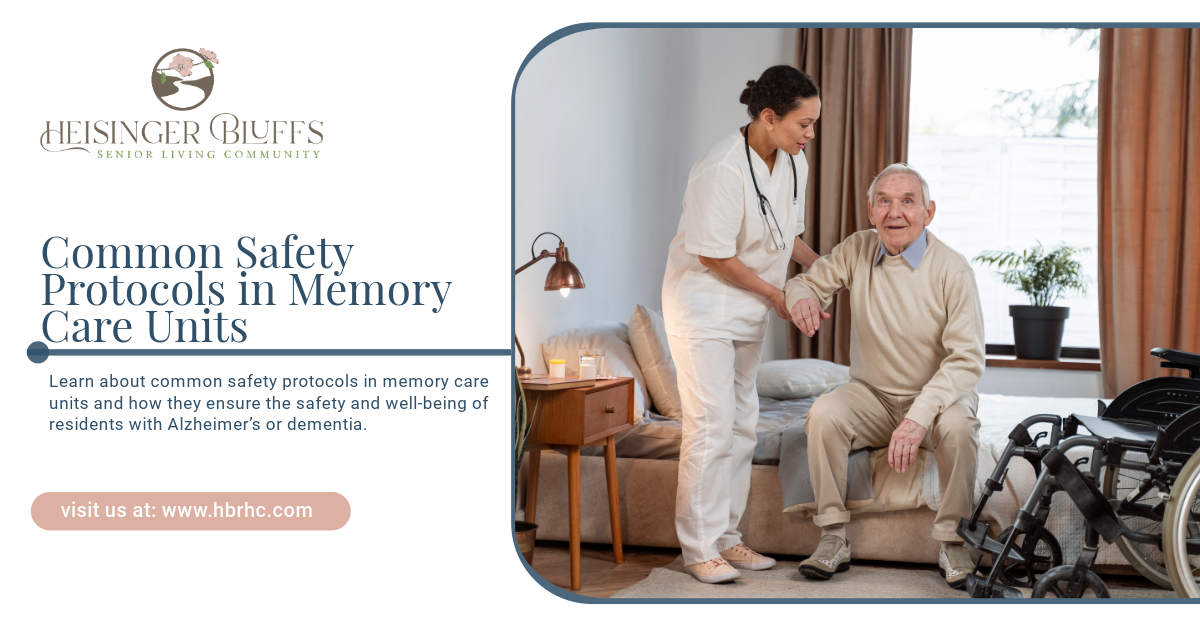Common Safety Protocols in Memory Care Units

Safety Protocols in Memory Care Units
Memory care units are specialized environments designed to cater to the unique needs of individuals with cognitive impairments such as Alzheimer's disease, dementia, or other memory-related conditions. While providing a comfortable and supportive environment, ensuring the safety of residents is paramount. Memory care facilities implement various safety protocols to minimize risks, enhance the residents' quality of life, and support their independence while providing necessary care.
In this blog post, we will explore the common safety protocols inmemory care units, why they are essential, and how they contribute to the overall well-being of residents. Understanding these protocols can give families peace of mind, knowing that their loved ones are in a secure and nurturing environment.
1. Secure and Safe Environment
One of the key priorities in memory care units is creating a secure and safe environment for residents. Cognitive impairments often make individuals prone to wandering, confusion, and difficulty navigating unfamiliar spaces. This increases the risk of accidents or injuries if not properly managed.
Secure Entrances and Exits
Memory care units are typically equipped with locked entrances and exits to prevent residents from leaving unsupervised. These secure areas are designed to give residents the freedom to roam within the facility but prevent them from wandering outside, where they could become disoriented or lost.
Some facilities also implement alarm systems on doors and windows. These systems alert staff members if a resident attempts to leave the premises, ensuring that staff can respond promptly and prevent any safety concerns.
Interior Design and Layout
The layout of memory care units is carefully designed to minimize confusion. Wide hallways, clearly marked rooms, and easily accessible spaces contribute to residents’ safety. The environment is often uncluttered, with clear visual cues to help residents navigate the space and avoid obstacles that could lead to falls.
In some cases, memory care units may use calming colors and familiar décor to create a comforting atmosphere that reduces anxiety and disorientation. These design elements are critical for maintaining a sense of familiarity and safety.
2. Monitoring and Surveillance Systems
Memory care units utilize advanced monitoring and surveillance systems to ensure the safety of their residents. These systems play a crucial role in providing staff with real-time information about the residents' activities, enabling them to respond quickly if a resident requires assistance.
CCTV Cameras
While respecting privacy, many memory care facilities employ discreet CCTV cameras in common areas to monitor residents. These cameras help ensure that staff can observe areas where residents gather, such as dining rooms or activity rooms, and provide immediate assistance if necessary.
Wearable Devices and Tracking Systems
Wearable devices such as GPS trackers or bracelets are often provided to residents in memory care units. These devices can track the resident’s location in real-time and alert caregivers if they wander or become lost. These systems also provide reassurance to families that their loved ones can be quickly located in case of an emergency.
3. Trained and Experienced Staff
A critical element of safety in memory care units is the staff's training and experience. The specialized care required by individuals with Alzheimer’s and dementia requires staff members to be well-versed in handling the specific challenges that these conditions present.
Staff Training in Dementia and Alzheimer’s Care
Memory care staff undergo extensive training in recognizing the signs of distress or agitation, preventing wandering, and managing challenging behaviors. This training also covers emergency protocols, such as how to respond to falls, medical emergencies, or behavioral outbursts. Staff are taught to provide care with patience, understanding, and compassion, recognizing that the needs of memory care residents differ significantly from those in other types of care facilities.
Staff-to-Resident Ratios
A sufficient number of trained staff members is essential for providing individualized attention and ensuring safety. Memory care units typically maintain a higher staff-to-resident ratio to ensure that residents receive the care and attention they need. This also reduces the likelihood of accidents or missed medical needs, as staff can monitor residents more closely.
4. Emergency Preparedness and Response Protocols
Memory care units must have a comprehensiveemergency preparedness plan in place. Given that residents may not always fully comprehend the seriousness of an emergency, such as a fire or medical situation, it is vital that staff are equipped to act quickly and effectively.
Fire Safety Protocols
Memory care units implement stringent fire safety protocols, including clearly marked exit routes, fire alarms, and sprinkler systems. Additionally, staff are trained in evacuation procedures specific to residents with memory impairments. In case of an emergency, staff must guide residents to safety, taking into account their mobility and cognitive abilities.
Medical Emergency Procedures
For residents with health conditions that require urgent care, memory care units are equipped with procedures for handling medical emergencies. These procedures include quick access to emergency medical personnel, immediate first-aid, and clear communication with family members if needed.
5. Fall Prevention Strategies
Falls are a common concern for seniors, particularly those with cognitive impairments. Memory care units implement a variety of fall prevention strategies to ensure that residents remain safe and mobile.
Non-Slip Flooring and Handrails
To reduce the risk of falls, memory care units often install non-slip flooring in hallways, bathrooms, and other high-risk areas. Handrails are also strategically placed throughout the facility, particularly in bathrooms and near stairs, to provide support when residents are walking or moving around.
Personalized Fall Risk Assessments
Each resident undergoes an individualized fall risk assessment to identify specific factors that might increase their likelihood of falling. Based on this assessment, staff can implement tailored interventions, such as providing mobility aids or monitoring specific residents more closely.
6. Medication Management and Safety
Many residents in memory care units require medication to manage health conditions orsymptoms of Alzheimer’s, dementia, or other cognitive disorders. Proper medication management is essential to ensure that medications are taken as prescribed and to prevent errors that could compromise residents' safety.
Medication Monitoring Systems
Memory care units use automated medication management systems to ensure that residents receive the correct dosage at the appropriate times. These systems reduce the risk of medication errors, such as missed doses or wrong medications, and improve the accuracy of record-keeping.
Staff Supervision
In addition to automated systems, staff closely monitor residents' medication intake. Some residents may need assistance with taking medication, and staff are trained to provide this assistance while respecting the residents’ autonomy.
7. Creating a Comforting and Calming Environment
Memory care units are designed to provide a calming and stress-free environment. This includes creating spaces that are familiar and comforting, minimizing noise and distractions, and offering sensory experiences that promote relaxation and well-being.
Familiar Activities and Routines
Residents often benefit from a structured yet flexible daily routine. By offering familiar activities, such as music therapy, art therapy, or simple games, memory care units create a sense of normalcy and security for residents. This also helps in reducing anxiety and agitation.
Calming Sensory Elements
Many memory care units include sensory rooms or spaces where residents can engage in activities that stimulate their senses in a soothing way. These spaces may feature soft lighting, calming music, and tactile objects, providing residents with an opportunity to relax and de-stress.
8. Family Involvement and Communication
Family involvement plays a significant role in ensuring the safety and well-being of residents in memory care units. Memory care facilities often encourage regular communication between staff and family members, ensuring that families stay informed and feel connected to their loved ones' care.
Regular Updates and Care Plan Meetings
Family members are invited to participate in care plan meetings, where staff can provide updates on the resident's progress and discuss any concerns. This helps ensure that family members remain actively involved in the care process and can advocate for their loved ones' needs.
Visitation Policies
Many memory care units have flexible visitation policies to allow families to visit their loved ones regularly. This promotes social interaction and provides families with an opportunity to monitor the care and safety of their loved ones.
Conclusion
Safety is a top priority in memory care units, and various protocols are put in place to ensure that residents are well-protected while maintaining their dignity and autonomy. From secure environments and trained staff to fall prevention strategies and emergency preparedness, these protocols help create a safe and supportive living environment for individuals with cognitive impairments. Families can rest assured that their loved ones are receiving the care and attention they need to thrive in a secure and nurturing environment.
If you are looking for a memory care unit that prioritizes safety, comfort, and personalized care,Heisinger Bluffs provides an ideal environment for your loved ones. Their expert staff and commitment to safety protocols ensure that residents receive the highest level of care.
Frequently Asked Questions
What are the most important safety protocols in memory care units?
The most important safety protocols include secure entrances and exits, monitoring systems, fall prevention strategies, and personalized care plans. These measures ensure the residents' physical and emotional safety.
How do memory care units prevent residents from wandering?
Memory care units prevent wandering by implementing secure entrances and exits, using tracking devices, and installing alarm systems. These measures ensure that residents are safe while still allowing them some freedom within the facility.
Can family members visit their loved ones in a memory care unit?
Yes, many memory care units have flexible visitation policies. Families are encouraged to visit regularly and participate in care plan meetings to stay involved in their loved ones' care.
Sources:
- https://pmc.ncbi.nlm.nih.gov/articles/PMC9054450/
- https://www.alz.org/help-support/caregiving/safety/in-a-disaster
- https://pmc.ncbi.nlm.nih.gov/articles/PMC7093636/
- https://www.alz.org/alzheimers-dementia/10_signs











